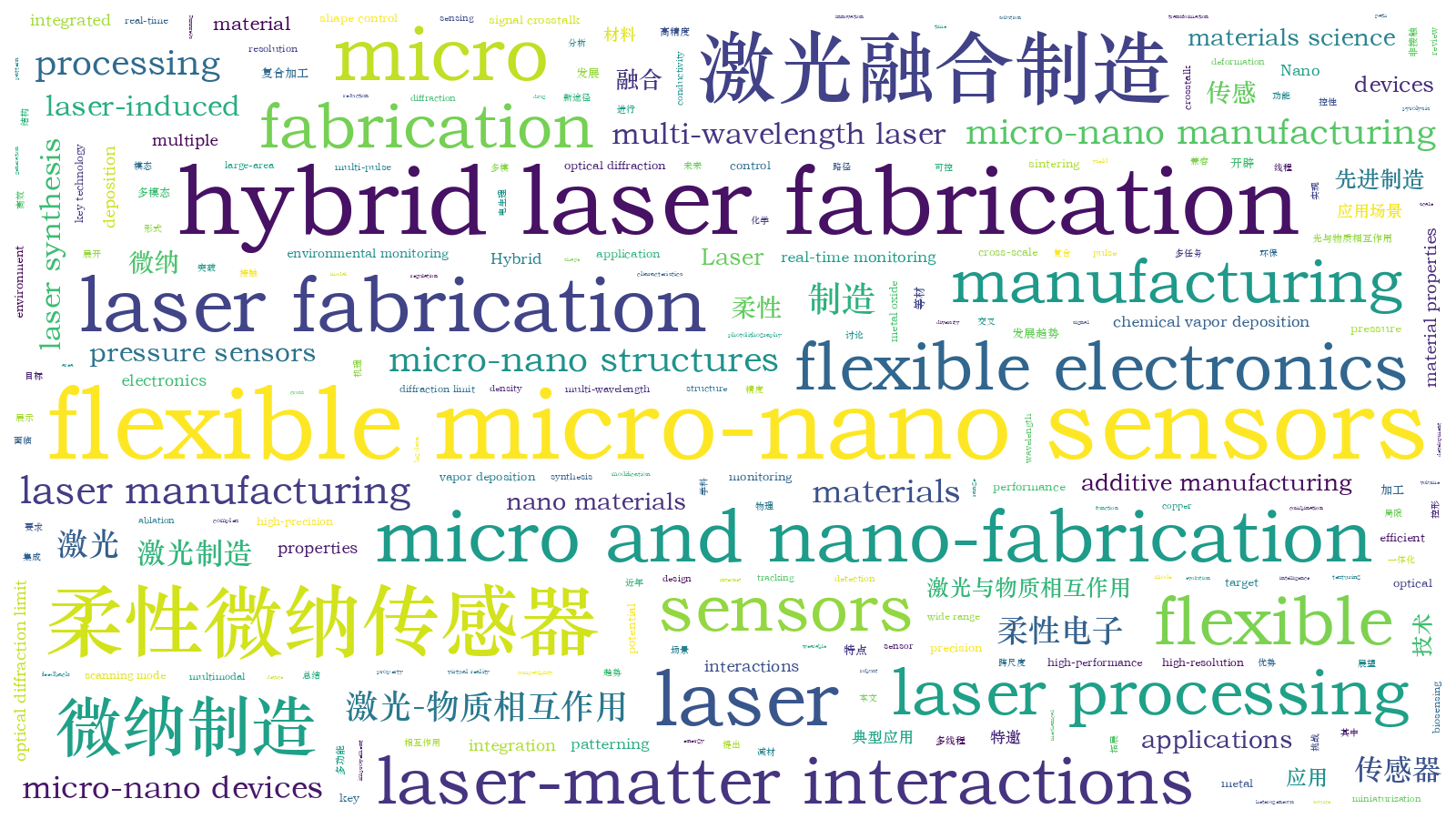激光融合制造及在柔性微纳传感器的应用(特邀)  下载: 708次特邀综述封面文章
下载: 708次特邀综述封面文章
With the increasing demands of internet-of-things and big data, flexible electronics have become a key technology. Among them, flexible micro-nano sensors, as an important part of flexible electronics, have revolutionized the physical form of conventional rigid devices. It has significantly facilitated the interconnections among human beings, machines, and environment, serving as a vital role for the advancement of intelligent electronics. For instance, embedding flexible micro-nano sensors in smart skins renders sensitive detection of external pressure and deformation, making them applicable in robotics and bionic hands. In biosensing applications, these sensors facilitate real-time monitoring of the internal micro-environment, drug release, and cellular activities. When applied in hand motion tracking and tactile feedback, they contribute to enhancing virtual reality interactions. It is envisioned that the emerging development of flexible micro-nano sensors will enable a new era of transformation within the industry.
Currently, a variety of commercial micro-nano manufacturing methods have been widely applied in micro-nano devices, including physical/chemical vapor deposition, photolithography, and nano-imprinting. However, the fabrication of multifunctional flexible micro-nano sensors often involves the combination of multiple manufacturing methods to achieve various tasks like sensitive material deposition, patterning, as well as generation of micro-nano structures. With the evolution of flexible micro-nano sensors towards miniaturization, integration, intelligence, and customization, the higher technical requirements are posed for the efficient multifunctional preparation of sensitive materials and the controllable fabrication of micro-nano structures.
Among various technologies available, hybrid laser fabrication based on laser additive, formative, and subtractive manufacturing, along with their combined processing modes, meets the heterogeneous requirements of multifunctional flexible micro-nano sensors in terms of multiple scales, dimensions, and materials. Leveraging its rich reaction mechanisms, flexible and controllable regulation, high-precision processing, and multi-material compatibility, it breaks through the limitations of traditional manufacturing technologies in multitasking, multithreading, and multifunctional combined processing. Based on laser and matter interactions, hybrid laser fabrication realizes cross-scale shape control and property control, which opens up a new path towards the integrated structure-material-function manufacturing of various flexible micro-nano sensors.
Several published review articles on “laser fabrication of flexible micro-nano sensors” are available, which mainly elaborate on laser synthesis of micro-nano materials and laser processing of micro-nano structures. This paper focuses on hybrid laser fabrication and discusses its application strategies in the realization of flexible micro-nano sensors from a global perspective. It sequentially introduces three laser-based manufacturing methods, including additive, formative, and subtractive fabrication. The processing mechanisms and typical target materials involved are discussed. The paper highlights the technical advantages and applications of hybrid laser fabrication in flexible micro-nano sensors (Fig.1).
In particular, based on different processing strategies of hybrid laser fabrication: (1) Laser additive manufacturing utilizes laser as a localized energy source to heat and melt nano-precursors, which accumulates layer by layer after sintering to form functional structures. Examples include laser reduction sintering of metal or metal oxide nano-inks such as copper, silver, and nickel (Fig.2). (2) Laser formative manufacturing refers to laser-induced interfacial reactions used to change the physical or chemical properties of materials, while almost maintaining their initial volume. This is typically used to regulate the conductivity or functionalize the properties of polymers (Fig.3). (3) Laser subtractive manufacturing mainly achieves pyrolysis, ablation, patterning, and micro-nano texturing of materials. For example, it is applied to enhance the performance of pressure sensors and fabricate high-resolution interconnect circuits (Fig.4). Rationally combining these three laser processing strategies makes it possible to deposit nano-materials, physicochemically modify sensitive media, and pattern and precisely form micro-nano structures in multifunctional devices. This makes it feasible for the multifunctional integration and versatile manufacturing of flexible micro-nano sensors, making it a potential alternative to traditional manufacturing methods.
Subsequently, this paper discusses some typical applications of hybrid laser fabrication in flexible physical, chemical, and electrophysiological sensors in recent years, as well as flexible multi-modal sensor systems. It comprehensively demonstrates a wide range of multifunctional applications in the fields of wearable healthcare, human-machine interactions, and environmental monitoring.
Hybrid laser fabrication involves multiple disciplines such as optical engineering, materials science, and mechanical manufacturing. Utilizing multi-pulse and multi-wavelength laser manufacturing systems, it judiciously integrates the characteristics of additive, formative, and subtractive processing, allowing efficient deposition of sensitive materials, modification of material properties, and precise preparation of micro-nano structures. This integration provides a robust solution for realizing high-performance flexible micro-nano sensors, overcoming the technical challenges of traditional methods. Nevertheless, there are still a couple of challenges to address for practical applications. First, the further improvement of precision is restricted by the optical diffraction limit, which hinders the manufacturing of high-density and highly integrated devices. Second, traditional laser processing mainly works through the point scanning mode, and the preparation of complex structures usually takes several hours or even longer, which greatly reduces the yield and cannot meet the needs of large-area or mass-processing. In addition, the diversity of target materials has posed a challenge for hybrid laser fabrication in relation to multimodal processing. Finally, in terms of device applications, overcoming signal crosstalk among different sensing units is a key issue in the design and fabrication of devices, given the potential of hybrid laser fabrication for the integrated processing of multifunctional sensors. In conclusion, hybrid laser fabrication is envisioned to accelerate the innovation of flexible micro-nano sensors and expand the application scenarios of laser processing.
蔡子墨, 匡翠方, 杨华勇, 洪明辉, 徐凯臣. 激光融合制造及在柔性微纳传感器的应用(特邀)[J]. 中国激光, 2024, 51(4): 0402403. Zimo Cai, Cuifang Kuang, Huayong Yang, Minghui Hong, Kaichen Xu. Hybrid Laser Manufacturing and Applications in Flexible Micro‐Nano Sensors (Invited)[J]. Chinese Journal of Lasers, 2024, 51(4): 0402403.







